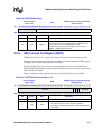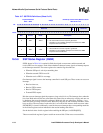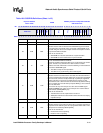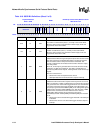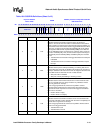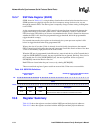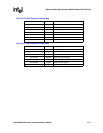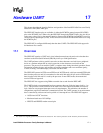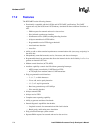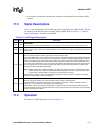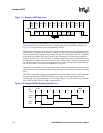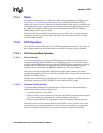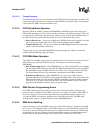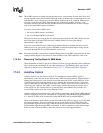
Intel® PXA26x Processor Family Developer’s Manual 17-1
Hardware UART 17
This chapter describes the signal definitions and operation of the Intel® PXA26x Processor Family
Hardware UART (HWUART) port.
The HWUART interface pins are available via either the PCMCIA general purpose I/O (GPIO)
pins or the BTUART pins. When using the HWUART through the PCMCIA pins, they are driven
at the same voltage level as the memory interface. Because the PCMCIA signal nPWE is used for
variable-latency input/output (VLIO), VLIO cannot be used while the HWUART interface is using
the PCMCIA pins.
The HWUART is configured differently than the other UARTs. The HWUART adds support for
full hardware flow control.
17.1 Overview
The HWUART contains a UART and a slow infrared transmit encoder and receive decoder that
conforms to the IrDA Serial Infrared (SIR) Physical Layer Link Specification.
The UART performs serial-to-parallel conversion on data characters received from a peripheral
device or a modem and parallel-to-serial conversion on data characters received from the
processor. The processor can read the UART’s complete status during functional operation. Status
information includes the type and condition of transfer operations and error conditions (parity,
overrun, framing, or break interrupt) associated with the UART.
The HWUART operates in FIFO or non-FIFO mode. In FIFO mode, a 64-byte transmit FIFO holds
data from the processor until it is transmitted on the serial link and a 64-byte receive FIFO buffers
data from the serial link until it is read by the processor. In non-FIFO mode, the transmit and
receive FIFOs are bypassed.
The HWUART also supports using DMA to transfer data to and from the HWUART.
The UART includes a programmable baud rate generator that can divide the input clock by 1 to
2
16
–1. This produces a 16X clock that can be used to drive the internal transmitter and receiver
logic. Software can program interrupts to meet its requirements. This minimizes the number of
computations required to handle the communications link. The UART operates in an environment
that is controlled by software and can be polled or is interrupt driven. The HWUART supports:
• 16550A and 16750
1
functions.
• Maximum baud rate of 921.6 Kbps.
• HWCTS and HWRTS modem control pins
1. The 16550A was originally produced by National Semiconductor Inc. The 16750 is produced as the TL16C750 by Texas Instruments.



